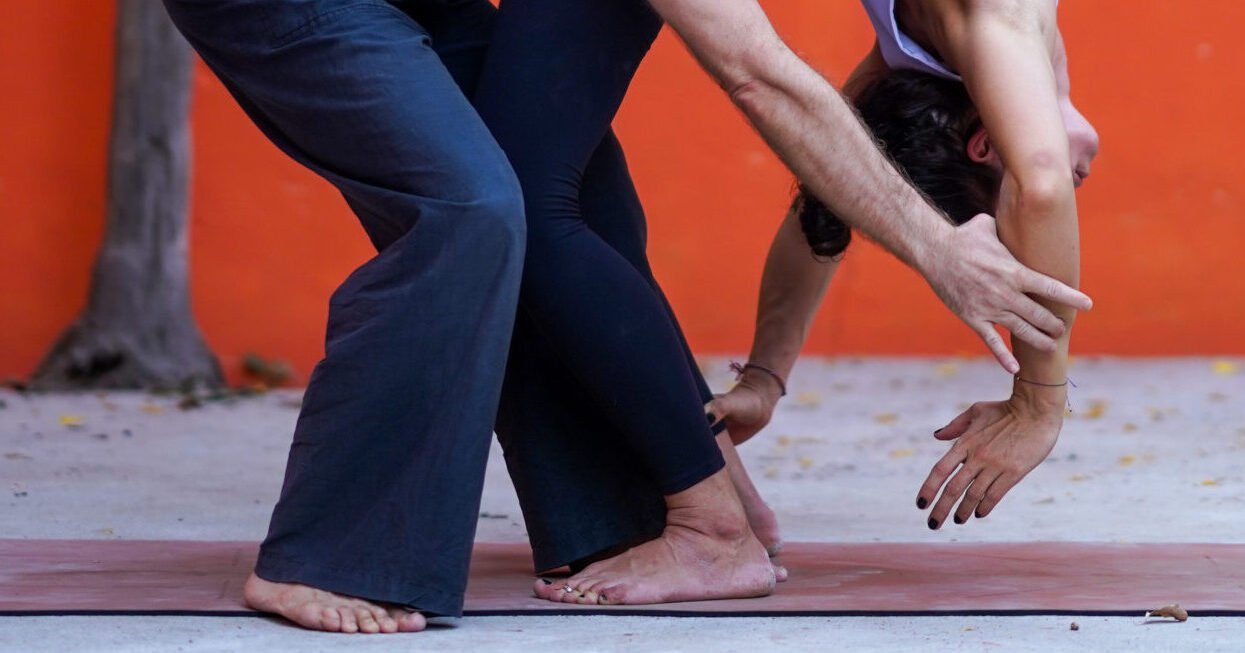Ashtanga Vinyasa Yoga, with its dynamic movements and precise alignments, offers practitioners an opportunity to deepen their understanding of the anatomy and physiology of their own bodies. But how can we integrate this knowledge to enhance our experience on the mat? In this article, we will explore the intricate interaction between anatomy and Ashtanga Vinyasa Yoga, discovering how the awareness of bodily structures can enrich your practice and promote overall well-being helping to break unhealthy posture patterns.
Contents
Understanding the Body in Ashtanga Vinyasa Yoga:
At its essence, Ashtanga Vinyasa Yoga is a holistic practice that integrates breath, movement, and alignment. Each asana engages multiple muscle groups, joints, and systems within the body, creating a symphony of movement and stability. Understanding the anatomy of key areas involved in this practice can enhance both safety and efficacy on the mat.
1. Spine
The spine serves as the central axis of our body, both in yoga practice and in our daily lives. Asanas such as Uttanasana (Standing Forward Bend) and Paschimottanasana (Seated Forward Bend) involve forward folding, promoting spinal flexion and decompression. Backbends like Urdhva Mukha Svanasana (Upward-Facing Dog) and Urdhva Dhanurasana (Upward Bow Pose) encourage extension, strengthening the back muscles and improving posture.
Additionally, poses such as Parivrtta Trikonasana (Revolved Triangle Pose), Ardha Matsyendrasana (Half Lord of the Fishes Pose), and Marichyasana C-D (Sage Marichi Pose C-D) involve twisting motions, which can enhance spinal mobility, release tension in the back, and stimulate digestion.
2. Core
The core, consisting of some of the muscles in the abdomen, lower back, and pelvis, is essential for connecting the upper and lower parts of the body and providing stability during yoga asana practice. Poses like Navasana (Boat Pose) and Chaturanga Dandasana (Four-Limbed Staff Pose) engage the core, building strength and endurance to support the spine and prevent injury.
3. Hips
The hips are pivotal in many yoga poses, especially in Ashtanga Vinyasa where hip opening is emphasized. Asanas such as Virabhadrasana (Warrior Poses), Baddha Konasana (Bound Angle Pose), and Marichyasana A-B (Sage Marichi Pose A-B) target the hip flexors, external rotators, and adductors, promoting flexibility and releasing tension stored in the hips.
4. Shoulders and Upper Body
Ashtanga Vinyasa sequences often incorporate weight-bearing poses that strengthen the shoulders, arms, and wrists. Poses like Adho Mukha Svanasana (Downward-Facing Dog) and Chaturanga Dandasana (Four-Limbed Staff Pose) build upper body strength and stability, while also improving shoulder mobility and flexibility.
5. Breath ad Respiratory System
Central to Ashtanga Vinyasa practice is the synchronization of breath with movement. Conscious breathing not only oxygenates the body but also calms the mind and enhances focus. Understanding the mechanics of breathing, including diaphragmatic breathing and ujjayi breath (the victorious breath), can deepen the connection between body and breath.
Benefits of Anatomy Awareness in Practice:
1. Injury Prevention
A thorough understanding of anatomy helps practitioners move mindfully, respecting their body’s limitations and avoiding injury. By cultivating body awareness, practitioners learn to recognize signs of strain and adjust their practice accordingly.
2. Alignment and Efficiency
Knowledge of anatomical alignment principles allows practitioners to refine their poses, maximizing their effectiveness and efficiency. Proper alignment minimises stress on joints and muscles, allowing for a safer and more sustainable practice.
3. Mind-Body Connection
Awareness of anatomy deepens the mind-body connection, fostering a greater sense of presence and mindfulness on the mat. As practitioners tune into the sensations within their bodies, they cultivate a deeper understanding of themselves and their practice.
4. Personalised Practice
Each body is unique, and an understanding of anatomy empowers practitioners to tailor their practice to suit their individual needs and goals. By recognizing their body’s strengths and limitations, practitioners can modify poses and sequences to optimize their practice experience.
Conclusions
Anatomy serves as the foundation upon which the practice of Ashtanga Vinyasa Yoga is built. By delving into the intricate workings of the body, practitioners gain invaluable insights that enhance their practice, promote safety, and deepen their connection to themselves. As we cultivate awareness of anatomy on the mat, we embark on a journey of self-discovery and empowerment, unlocking the full potential of body, mind, and spirit through the transformative practice of Ashtanga Vinyasa Yoga.
With Every Breath, Make Space. With Every Asana, Discover Balance.






